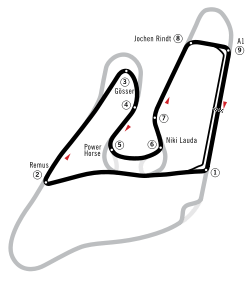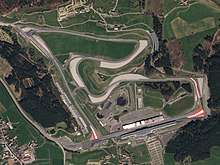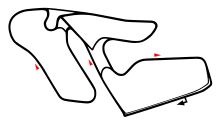Red Bull Ring
The Red Bull Ring is a motorsport race track in Spielberg, Styria, Austria.[2]
  | |
| Location | Spielberg, Styria, Austria |
|---|---|
| Time zone | UTC+01:00 |
| Coordinates | 47°13′11″N 14°45′53″E |
| Capacity | 40,000 |
| FIA Grade | 1 |
| Former names | Österreichring (1969–1995) A1-Ring (1996–2004) |
| Major events | Formula One Austrian Grand Prix Styrian Grand Prix (2020) DTM ELMS 4 Hours of Red Bull Ring MotoGP Austrian motorcycle Grand Prix |
| Red Bull Ring (2016–present) | |
| Length | 4.318 km (2.683 mi) |
| Turns | 10[1] |
| Race lap record | 1:05.619 ( |
| A1-Ring (1996–2004) Red Bull Ring (2011–2016) | |
| Length | 4.326 km (2.688 mi) |
| Turns | 9 |
| Race lap record | 1:08.337 ( |
| Österreichring (with Hella Licht chicane) (1977–1995) | |
| Length | 5.941 km (3.692 mi) |
| Turns | 18 |
| Race lap record | 1:23.357 ( |
| Österreichring (original circuit) (1969–1976) | |
| Length | 5.911 km (3.673 mi) |
| Turns | 16 |
| Race lap record | 1:34.850 ( |
The race circuit was founded as Österreichring and hosted the Austrian Grand Prix for 18 consecutive years, from 1970 to 1987. It was later shortened, rebuilt and renamed the A1-Ring (A Eins-Ring), and it hosted the Austrian Grand Prix again from 1997 to 2003. When Formula One outgrew the circuit, a plan was drawn up to extend the layout. Parts of the circuit, including the pits and main grandstand, were demolished, but construction work was stopped and the circuit remained unusable for several years before it was purchased by Red Bull's Dietrich Mateschitz and rebuilt. Renamed the Red Bull Ring the track was reopened on 15 May 2011[3] and subsequently hosted a round of the 2011 DTM season[4][5] and a round of the 2011 F2 championship. Formula One returned to the circuit in the 2014 season.
Österreichring (1969–1995)
Gerhard Berger (speaking in 2007) on the turbocharged Benetton-BMW he drove in F1 in the 1986 season.[6]

Originally built in 1969 to replace the bland and bumpy Zeltweg Airfield circuit located just across the street, the Österreichring track was situated in the Styrian mountains and it was a spectacular, scenic and unique circuit. The track was very fast, every corner was a fast sweeper and was taken in no lower than 3rd gear in a 5-speed gearbox and 4th in a 6-speed gearbox. It had noticeable changes in elevation during the course of a lap, 65 metres from lowest to highest point. Like most fast circuits it was a hard circuit on engines but more difficult on tires, because of the speeds being so consistently high. Many considered the Österreichring to be dangerous, especially the Bosch Kurve, a 180-degree downhill right-hand corner with almost no run-off area which, by 1986 when turbos pushed Formula One engine power to upwards of 1,400 bhp (1,044 kW; 1,419 PS) in qualifying, saw Derek Warwick speed trapped at 344 km/h (214 mph) in his BMW powered Brabham BT55 on the run to the Bosch Kurve. There were other testing corners such as Voest-Hugel, which was a flat-out 180 mph right hander that eventually led to the 150 mph Sebring-Auspuff Kurve (this corner had many names over the years, Dr. Tiroch and Glatz Kurve were others) which was an essential corner to get right because of the long straight afterwards that led to the Bosch Kurve.
Some of the track was just road with little to no protection at all, even up to the final Austrian Grand Prix there in 1987, a race that had to be restarted twice because of 2 progressively more serious accidents both caused by the narrow pit straight in a similar manner to the 1985 race when the race was stopped after one lap following a start line shunt that had taken out three cars including championship leader Michele Alboreto's Ferrari and local driver Gerhard Berger's Arrows-BMW. In practice for the 1987 race McLaren's Stefan Johansson narrowly avoided serious injury or worse when at over 150 mph he collided with a deer that had made its way onto the track while Johansson was cresting a blind brow before the Jochen Rindt Kurve behind the pits.
Increasing speeds were also a concern at the Österreichring; during the final Grand Prix there in 1987 pole-sitter Nelson Piquet's time for the 5.942 km (3.692 mi) of 1:23.357 set an average speed record for the circuit of 159.457 mph (255.756 km/h). At the time it was second only in F1 average speed to Keke Rosberg's 160.9 mph (258.9 km/h) pole lap of the Silverstone Circuit set during the 1985 British Grand Prix. Both times were set using a turbocharged Williams-Honda.
American driver Mark Donohue died after crashing at the Vost-Hugel Kurve in 1975. In 1976, the Vost-Hugel Kurve was tightened and made into one right hander rather than 2 right-handers with a small section between, and in 1977 it was slowed down and became the Hella-Licht chicane, going from the fastest to the slowest corner on the track. It is also known that four-times World Champion Alain Prost often said that all tracks can be changed but that the Österreichring should remain unchanged, just adding run-off areas would be fine, which eventually did happen up until the original track's final year in 1995. The track was known for having many crashes at the start of races (especially 6-foot-wide [1.8 m] Formula One cars at the Austrian Grand Prix) because the start–finish straight was very narrow (about 30 feet wide [9.1 m], while most start–finish straights on other tracks were 60 to 80 feet wide [18 to 24 m]) and it did not provide enough space for cars attempting to pass others, especially cars that stalled or broke at the start. Motorcycle rider Hans-Peter Klampfer died after a collision with another rider at the Bosch Kurve (where most fatalities happened) and 29-year-old Hannes Wustinger was also killed after a crash at the Tiroch Kurve (the part that was left out of the present circuit) at a race for the Austrian Touring car championship and this sealed the decision to build a new circuit.
Triple World Champion and long time hero of the home crowd Niki Lauda is the only Austrian driver to win his home Grand Prix. He won the 1984 Austrian Grand Prix at the Österreichring driving a McLaren-TAG Porsche. Lauda went on to win his third and final championship in 1984, beating his teammate Alain Prost by the smallest margin in F1 history, only half a point. He announced his permanent retirement from driving at the circuit before the 1985 race.
A1-Ring (1996–2003)

The Österreichring's safety concerns had reached a head in the mid 1990s, and in 1995 and 1996 it was totally rebuilt, at the same site, by Hermann Tilke. Its length was shortened from 5.942 km (3.692 mi) to 4.326 km (2.688 mi), and the fast sweeping corners were replaced by three tight right-handers, in order to create overtaking opportunities. Its three long straights, as well as a twisty infield section, asked for a setup compromise.
As much of the construction work was paid for by the mobile phone provider A1, the track was renamed the A1-Ring.[7] It proceeded to host seven Formula One Austrian Grands Prix between 1997 and 2003, as well as several DTM races and the Austrian motorcycle Grand Prix in 1996 and 1997.
Red Bull Ring (2011–present)


The grandstands and pit buildings were demolished in 2004, rendering the track unusable for any motorsport category.
In late 2004 and early 2005, there were intense discussions concerning whether the owner of the circuit, Red Bull, would find another use for the site, or return motor sports to the venue. There was a circuit extension proposal using part of the old Österreichring. In January 2005, return of motor sports seemed more unlikely than ever, as Dietrich Mateschitz publicly announced that he had no intention of wasting money on a deficient circuit. Throughout 2005 however, there was speculation of the newly founded Red Bull Racing renovating the track to use it as a test venue.
In 2006, Austrian racing driver Alexander Wurz claimed he would buy the circuit and have it renovated, but the idea never came to fruition. By 2007, talks involving Red Bull, KTM, Volkswagen and Magna International for a neuer Österreichring failed, after VW pulled out.[8]
Late in 2008, Red Bull began their €70m reconstruction of the track and DTM chiefs considered a return to the circuit in 2009,[9][10] and in September 2010, it was confirmed that the circuit would host a round of the 2011 DTM season,[4][5] now known as the Red Bull Ring. The championship has visited the circuit every year since then until 2018.
In November 2010, F2 announced that Round 6 of the 2011 F2 championship would take place at the Red Bull Ring. The circuit was reopened at a special event over the weekend of 15–16 May 2011, which included displays of various Red Bull sponsored teams including Red Bull Racing. The FIA Historic Formula One Championship was invited to provide the headline race attraction with a race on each day for Formula One cars from the 3-litre period.
In December 2012, Red Bull contacted the FIA to say the track would be available to host a round of the Formula One World Championship in 2013, after a slot became available following the postponement of the proposed New York metropolitan area Grand Prix of America,[11] and by July 2013, Red Bull announced that the Austrian Grand Prix would return as a round of the Formula One World Championship in 2014. The Austrian Grand Prix was held on 22 June 2014.
From 2014 until 2016, the track also hosted a round of the Red Bull Air Race World Championship.
On February 11, 2016, it was announced that MotoGP would return to the circuit in 2016 for the first time since 1997.[12]
On June 30, 2019, in honour of the late 3-time Formula One World Champion Niki Lauda, the first turn of the track was renamed the "Niki Lauda Curve".[13]
On May 30, 2020, it was reported that the Austrian government had given permission for two Formula One races to be held on 5 and 12 July 2020 respectively to kick off the 2020 Formula One season after its start had been delayed by the COVID-19 pandemic.[14]
On June 2, 2020, Formula 1 confirmed the Red Bull Ring would hold back to back races on 5 and 12 July to start the 2020 season, with the second race styled as a one-off Styrian Grand Prix. It will also hold the first four races of the 2020 FIA Formula 2 Championship and the 2020 FIA Formula 3 Championship. This first of the F1 races makes the circuit the first European circuit to host the opening round of a Formula One season since the Circuit de Monaco did this in the 1966 Formula One Season as well as the first time Austria has hosted the opening race of the World Championship and therefore the first time the circuit has hosted the opening round - an honour given to 13 previous venues since the inception of the World Championship in 1950.[15]
Lap records
The lap records at the Red Bull Ring.
| Class | Category | Time | Driver | Vehicle | Date |
|---|---|---|---|---|---|
| Current Circuit: 4.318 km (2016–present) | |||||
| Outright | Formula One | 1:02.939 | Valtteri Bottas | Mercedes-AMG F1 W11 EQ Performance | 2020 Austrian Grand Prix |
| Class | Category | Time | Driver | Vehicle | Date |
| Race | Formula One | 1:05.619 | Carlos Sainz Jr. | McLaren-Renault MCL35 | 2020 Styrian Grand Prix |
| MotoGP | 1:24.277 | Andrea Dovizioso | Ducati Desmosedici GP18 | 2018 Austrian motorcycle Grand Prix | |
| Class | Category | Time | Driver | Vehicle | Date |
| A1-Ring/Red Bull Ring: 4.326 km (1996–2016) | |||||
| Race | Formula One | 1:08.337 | Michael Schumacher | Ferrari F2003-GA | 2003 Austrian Grand Prix |
| Österreichring: 5.941 km (1977–1995) | |||||
| Race | Formula One | 1:23.357 | Nelson Piquet | Williams-Honda FW11B | 1987 Austrian Grand Prix |
| Original Circuit: 5.911 km (1969–1976) | |||||
| Race | Formula One | 1:34.850 | Niki Lauda | Ferrari 312T | 1975 Austrian Grand Prix |
Concerts
| Date | Performer | Tour |
|---|---|---|
| 11 June 1995 | Bon Jovi | These Days Tour |
| 1 August 1995 | The Rolling Stones | Voodoo Lounge Tour |
| 15 August 2000 | Bon Jovi | Crush Tour |
| 14 May 2015 | AC/DC | Rock or Bust World Tour |
| 16 September 2017 | The Rolling Stones | No Filter Tour |
References
- "NeroGiardini Motorrad Grand Prix von Österreich – Circuit information: Red Bull Ring – Spielberg" (PDF). MotoGP.com. Dorna Sports. 11 August 2016. Retrieved 12 August 2016.
- The Spielberg Project"
- Vettel, Lauda & Marko on the Red Bull Ring
- Austria back on DTM schedule in '11
- Der DTM-Kalender 2011 – Spannung in sechs Nationen (in German) Archived February 29, 2012, at the Wayback Machine
- van de Burgt, Andrew, ed. (December 2007). "Photo Finish: The Story Behind the Picture – 1986: Austrian Grand Prix". Autosport. Vol. 190 no. 12. p. 102.
- CIRCUITS: A1 RING
- Wenig Chance auf neue Spielberg-Partner – oesterreich.ORF.at (in German)
- DTM considering return to Austria
- Spielberg-Verträge sollen neu verhandelt werden (in German)
- "Red Bull offers own track for Austrian GP return in 2013". bbc.co.uk. BBC. 9 December 2012. Retrieved 11 December 2012.
- "2016 MotoGP™ Calendar confirmed". MotoGP.com. Dorna Sports. 11 February 2016. Retrieved 30 June 2016.
- "Turn 1 in Austria renamed in honour of Niki Lauda". F1.com. Formula One Group. 30 June 2019. Retrieved 30 June 2019.
- "Austria set to host Formula 1 season openers in July". 30 May 2020. Retrieved 31 May 2020 – via www.bbc.co.uk.
- https://www.motorsport.com/f1/news/which-circuits-hosted-f1-season-opener/4818968/?utm_source=home-page-widget&utm_medium=widget&utm_campaign=widget-1
External links
| Wikimedia Commons has media related to |